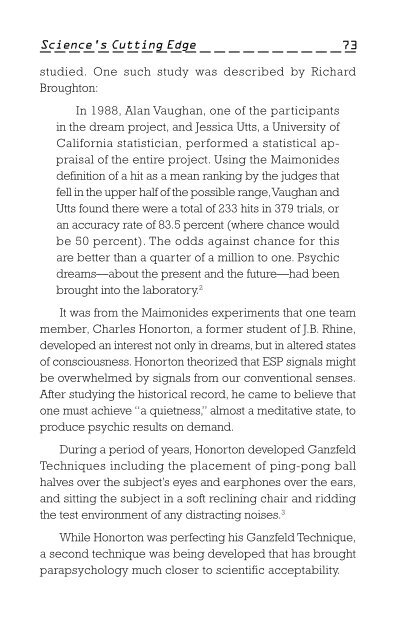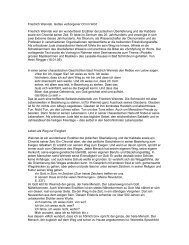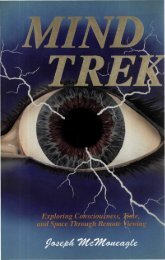- Page 5 and 6:
This page intentionally left blank
- Page 8 and 9:
ContentsPreface9Author’s s Note 1
- Page 10 and 11:
Preface 9PrefaceIn 1992, following
- Page 12 and 13:
Preface 11The response was almost u
- Page 14 and 15:
Preface 13In mid-1995, as the book
- Page 16 and 17:
Preface 15RV. The report concluded
- Page 18 and 19:
Preface 17A frequent guest on late-
- Page 20 and 21:
Preface 19Author’s NotePlease not
- Page 22 and 23:
PsiInt: Psychic Intelligence 21Chap
- Page 24 and 25: PsiInt: Psychic Intelligence 23More
- Page 26 and 27: PsiInt: Psychic Intelligence 25coul
- Page 28 and 29: PsiInt: Psychic Intelligence 27“T
- Page 30 and 31: PsiInt: Psychic Intelligence 29FLAM
- Page 32 and 33: PsiInt: Psychic Intelligence 31He p
- Page 34 and 35: PsiInt: Psychic Intelligence 33more
- Page 36 and 37: PsiInt: Psychic Intelligence 35Look
- Page 38 and 39: PsiInt: Psychic Intelligence 37imme
- Page 40 and 41: PsiInt: Psychic Intelligence 39Mome
- Page 43 and 44: This page intentionally left blank
- Page 45 and 46: 44PSI Spiesfrom Patanjali’s Yoga
- Page 47 and 48: 46PSI SpiesOn the appointed day, Cr
- Page 49 and 50: 48PSI Spiesbeautiful Indian woman I
- Page 51 and 52: 50PSI Spiesof night that reveal to
- Page 53 and 54: 52PSI SpiesBacon described modern e
- Page 55 and 56: 54PSI Spiesnear Italy [who] will co
- Page 57 and 58: 56PSI SpiesAlthough certain variati
- Page 59 and 60: 58PSI Spieswere not pleased with th
- Page 61 and 62: 60PSI Spiesrealm, from which we rec
- Page 63 and 64: 62PSI Spiestheir teenage years, and
- Page 65 and 66: 64PSI SpiesEven the most cursory lo
- Page 67 and 68: 66PSI SpiesAs Morehouse fumbled wit
- Page 69 and 70: 68PSI SpiesMorehouse was again perp
- Page 71 and 72: This page intentionally left blank
- Page 73: 72PSI SpiesDespite the impressive h
- Page 77 and 78: 76PSI Spiesexperimenter or just a f
- Page 79 and 80: 78PSI SpiesOne particular incident
- Page 81 and 82: 80PSI SpiesMercenary quickly began
- Page 83 and 84: 82PSI SpiesTime-Life Books describe
- Page 85 and 86: 84PSI SpiesSwann told of the occasi
- Page 87 and 88: 86PSI Spiesthe laser signal got the
- Page 89 and 90: 88PSI Spies“This made me mad,”
- Page 91 and 92: 90PSI SpiesBut successful experimen
- Page 93 and 94: 92PSI Spiesto designate a target lo
- Page 95 and 96: 94PSI SpiesIn a 1993 interview, Swa
- Page 97 and 98: 96PSI Spiescap. Years later the sto
- Page 99 and 100: 98PSI SpiesSecret Police, and other
- Page 101 and 102: 100PSI Spiesscientific mainstreams.
- Page 103 and 104: 102PSI SpiesIntelligence (OSI), met
- Page 105 and 106: 104PSI Spiesabout remote viewing. I
- Page 107 and 108: 106PSI Spieslittle more than a drea
- Page 109 and 110: 108PSI Spies“Since we did not nee
- Page 111 and 112: 110PSI SpiesStill skeptical, V1 ask
- Page 113 and 114: 112PSI Spiesdescriptions of office
- Page 115 and 116: 114PSI SpiesAccording to Time-Life
- Page 117 and 118: 116PSI Spiesof seven experiments.
- Page 119 and 120: 118PSI SpiesAnother consulting firm
- Page 121 and 122: 120PSI Spiesthe breakup of an OPEC
- Page 123 and 124: This page intentionally left blank
- Page 125 and 126:
124PSI SpiesBut most insurmountable
- Page 127 and 128:
126PSI SpiesAccording to Riley, the
- Page 129 and 130:
128PSI SpiesRiley said in boot camp
- Page 131 and 132:
130PSI SpiesWell, one day I was com
- Page 133 and 134:
132PSI SpiesOne of the biggest reas
- Page 135 and 136:
134PSI SpiesBut as the viewers gain
- Page 137 and 138:
136PSI Spieslocate small targets ne
- Page 139 and 140:
138PSI Spiesgoing on—up to and in
- Page 141 and 142:
140PSI SpiesHe defined “psychotro
- Page 143 and 144:
142PSI Spiesway they seem....The po
- Page 145 and 146:
144PSI Spiesit was what happened af
- Page 147 and 148:
146PSI Spiesthey decided to use me
- Page 149 and 150:
This page intentionally left blank
- Page 151 and 152:
150PSI Spiesothers could clearly pr
- Page 153 and 154:
152PSI Spiesin his environment or w
- Page 155 and 156:
154PSI Spiessuch as smells, sounds,
- Page 157 and 158:
156PSI Spiesmind, although apparent
- Page 159 and 160:
158PSI SpiesI let him off the hook
- Page 161 and 162:
160PSI Spiesthe DIA (Defense Intell
- Page 163 and 164:
162PSI SpiesBut Swann did hold on t
- Page 165 and 166:
164PSI Spiesto that effect. As a co
- Page 167 and 168:
166PSI Spiesvariety of techniques i
- Page 169 and 170:
168PSI SpiesSo I concentrated and,
- Page 171 and 172:
170PSI Spiesof the psychic heart at
- Page 173 and 174:
172PSI SpiesFollowing the operation
- Page 175 and 176:
174PSI Spiesbeen mainly interested
- Page 177 and 178:
176PSI SpiesThe only group I don’
- Page 179 and 180:
178PSI Spiestreated and this progra
- Page 181 and 182:
180PSI Spiesthe spin of the photons
- Page 183 and 184:
182PSI SpiesI certainly didn’t di
- Page 185 and 186:
184PSI SpiesIn 1984, the Army Resea
- Page 187 and 188:
186PSI Spiesand important in the mi
- Page 189 and 190:
188PSI Spiesuse of Ray Hyman as cha
- Page 191 and 192:
190PSI SpiesThe parapsychologists
- Page 193 and 194:
192PSI Spiesbecome somewhat agitate
- Page 195 and 196:
194PSI SpiesLyn Buchanan explained:
- Page 197 and 198:
196PSI Spieswho could help both him
- Page 199 and 200:
198PSI Spies“They just had their
- Page 201 and 202:
This page intentionally left blank
- Page 203 and 204:
202PSI SpiesOne practice session in
- Page 205 and 206:
204PSI Spiesevaluation or collation
- Page 207 and 208:
206PSI SpiesAs reported by unit mem
- Page 209 and 210:
208PSI Spiesphases, until they arri
- Page 211 and 212:
210PSI SpiesI had just entered Phas
- Page 213 and 214:
212PSI SpiesIt was something so tot
- Page 215 and 216:
214PSI Spiesviewer’s body is in o
- Page 217 and 218:
216PSI Spiesstill sitting at the ta
- Page 219 and 220:
218PSI SpiesOne main reason the Psi
- Page 221 and 222:
220PSI SpiesQuickly, the members of
- Page 223 and 224:
222PSI SpiesThe writer’s hopes fo
- Page 225 and 226:
224PSI SpiesAnother aspect of accur
- Page 227 and 228:
226PSI Spiesas if you were an unaff
- Page 229 and 230:
228PSI Spiesmy drawing, which carri
- Page 231 and 232:
230PSI Spiespossible deception sche
- Page 233 and 234:
232PSI Spiesto Maj. Jansen stated:
- Page 235 and 236:
234PSI Spiessee, I was a total skep
- Page 237 and 238:
236PSI SpiesAmerica’s first psi s
- Page 239 and 240:
238PSI SpiesAsked to mark precisely
- Page 241 and 242:
240PSI SpiesRiley said under tight
- Page 243 and 244:
242PSI Spiesno wings. Asked if he s
- Page 245 and 246:
244PSI Spiesof greenish-yellow. If
- Page 247 and 248:
246PSI Spiesvarious parties, includ
- Page 249 and 250:
248PSI Spiescratered surface and tr
- Page 251 and 252:
250PSI Spieswas around. There were
- Page 253 and 254:
252PSI Spieshave the ability to com
- Page 255 and 256:
254PSI Spies“The outlook is grim,
- Page 257 and 258:
256PSI Spiesdisappearance of Amelia
- Page 259 and 260:
258PSI SpiesPrice had remote viewed
- Page 261 and 262:
260PSI Spiesbetween species not onl
- Page 263 and 264:
262PSI Spiesthe impressions just dr
- Page 265 and 266:
264PSI SpiesThen I remembered what
- Page 267 and 268:
266PSI Spiesmysteries—such as the
- Page 269 and 270:
268PSI Spiesand locking up servo me
- Page 271 and 272:
270PSI Spiesofficial in the Soviet
- Page 273 and 274:
272PSI Spiesan altitude of about 11
- Page 275 and 276:
274PSI Spiesthe attributes of both
- Page 277 and 278:
276PSI Spiesand even other dimensio
- Page 279 and 280:
278PSI SpiesMel Riley retired from
- Page 281 and 282:
280PSI SpiesIn 2007, Ingo Swann was
- Page 283 and 284:
282PSI Spiesin the guild system, co
- Page 285 and 286:
284PSI SpiesI finally reached Lyn a
- Page 287 and 288:
286PSI SpiesI found her fun and wit
- Page 289 and 290:
288PSI SpiesUnfortunately, you will
- Page 291 and 292:
290PSI Spiesakin to that of a cyclo
- Page 293 and 294:
292PSI Spiesseven out of nine tests
- Page 295 and 296:
294PSI SpiesTHROUGH TIME AND SPACEJ
- Page 297 and 298:
296PSI SpiesCourtesy of U.S. Govern
- Page 299 and 300:
298PSI SpiesCourtesy of Jim MarrsRE
- Page 301 and 302:
300PSI Spies6. Steve Wall and Harve
- Page 303 and 304:
302PSI SpiesChapter 31. Broughton,
- Page 305 and 306:
304PSI Spies12. Martin Ebon, Psychi
- Page 307 and 308:
306PSI SpiesChapter 51. Mel Riley,
- Page 309 and 310:
308PSI Spies8. “Session Summary,
- Page 311 and 312:
310PSI Spies21. William F. Allman,
- Page 313 and 314:
312PSI SpiesBroughton, Dr. Richard,
- Page 315 and 316:
314PSI Spiesof Electronic and Elect
- Page 317 and 318:
316PSI SpiesPK, 62-63planetologists
- Page 319 and 320:
318PSI SpiesSubcommittee on Parapsy








